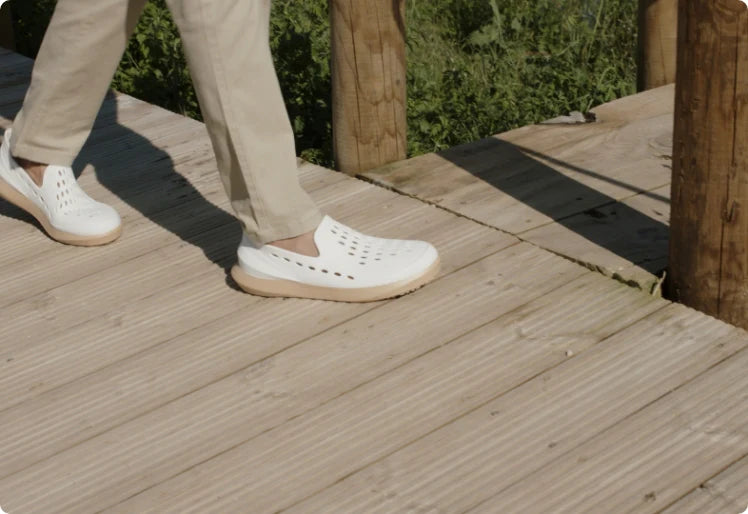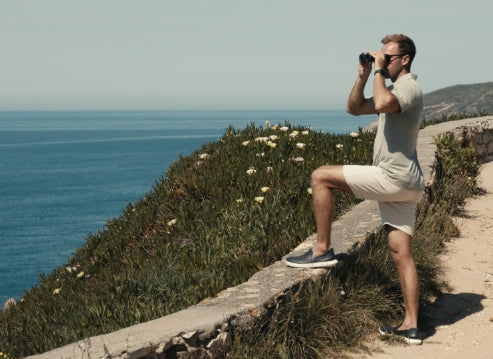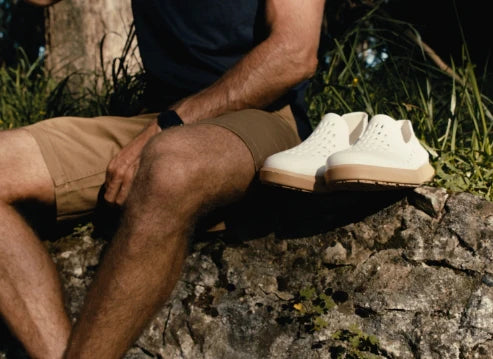Your water shoes are essential gear for aquatic adventures, protecting your feet while providing comfort during water activities. These specialized shoes require proper maintenance to maintain their functionality and extend their lifespan.
Regular washing, cleaning, and storing of your water shoes isn't just about keeping them looking fresh - it's about preserving their key features. Proper care prevents the buildup of bacteria, eliminates unpleasant odors, and maintains the integrity of materials designed for water resistance and quick drying.
Benefits of proper water shoe care include:
- Extended durability of materials and construction
- Enhanced grip and traction performance
- Prevention of bacterial growth and odors
- Maintained water drainage capabilities
- Preserved comfort and fit
Whether you're a casual beach-goer or a dedicated water sports enthusiast, learning the correct techniques for washing, cleaning, and storing your water shoes will protect your investment and ensure they're ready for your next water adventure.
Understanding Water Shoes
Water shoes are specialized footwear designed to protect your feet during aquatic activities while providing comfort and functionality in wet conditions. These versatile shoes bridge the gap between regular athletic footwear and barefoot water activities, offering essential protection without compromising performance.
Key Features of Water Shoes:
- Drainage Systems: Strategic holes or mesh panels allow water to escape quickly, preventing waterlogging and maintaining lightweight comfort
- Quick-Drying Materials: Advanced synthetic fabrics that shed water efficiently and dry rapidly
- Non-Slip Soles: Specially designed rubber outsoles with enhanced grip patterns for wet surfaces
- Protective Elements: Reinforced toe caps and heel support to guard against rocks and sharp objects
- Lightweight Design: Minimal weight construction to reduce fatigue during extended water activities
Common Materials Used:
Upper Construction:
- Synthetic mesh
- Neoprene
- Quick-dry textiles
- Breathable polyester
Sole Construction:
- Rubber compounds
- EVA foam
- Phylon midsoles
- TPR (Thermoplastic Rubber)
These materials work together to create a shoe that performs optimally in wet environments. The combination of breathable uppers and water-resistant components ensures your feet stay comfortable while participating in activities like kayaking, paddleboarding, or beach walking.
The design prioritizes both protection and sensory feedback, allowing you to maintain balance and stability on slippery surfaces. The lightweight nature of water shoes makes them ideal for packing on trips and wearing during extended water-based activities.
Washing Water Shoes
Keeping your water shoes clean ensures optimal performance and extends their lifespan. You can choose between two effective cleaning methods: machine washing and hand washing.
Machine Washing
Machine washing works best for water shoes made from durable materials like nylon, polyester, or cotton blends. Before tossing your shoes in the washer:
- Check the care label for specific washing instructions
- Remove loose dirt and debris
- Untie shoelaces and remove any removable insoles
- Place shoes in a mesh laundry bag to prevent damage
Machine Washing Settings:
- Water Temperature: Cold or warm (never hot)
- Cycle: Gentle or delicate
- Detergent: Mild liquid detergent
- Spin Speed: Low to medium
Pro tip: Add a few old towels to the wash load to prevent your shoes from banging around during the cycle.
Hand Washing Water Shoes
Hand washing gives you greater control over the cleaning process and suits all types of water shoes, especially those with delicate materials or special coatings.
Step-by-Step Hand Washing Guide:
Initial Rinse
- Remove excess dirt under running water
- Use a soft brush to dislodge stuck debris
- Pay special attention to the soles and drainage holes
Prepare Cleaning Solution
- Fill a basin with lukewarm water
- Add a small amount of mild detergent
- Mix until you see gentle suds
Cleaning Process
- Submerge shoes in the solution
- Use a soft brush or cloth for scrubbing
- Clean the exterior thoroughly
- Pay attention to seams and crevices
- Gently clean the insoles and interior
Detailed Cleaning
- Focus on heavily soiled areas
- Use circular motions with your brush
- Clean drainage holes to prevent clogging
- Scrub soles with slightly firmer pressure
Thorough Rinse
- Rinse under clean running water
- Continue until water runs clear
- Squeeze gently to remove excess water
It's important to note that not all water shoes are created equal. Depending on your lifestyle, you might prefer slip-on shoes for their ease of use, or lace-up shoes for a more secure fit. If you're someone who spends long hours on your feet, investing in the best shoes for 12-hour shifts could significantly improve your comfort and job performance. On the other hand, if you're considering using hiking shoes as water shoes due to their ruggedness, you might want to read about whether hiking shoes are good for walking, as they may not always be suitable for such activities.
Drying Water Shoes Properly
Water shoes need specific drying techniques to maintain their shape and prevent damage. Direct sunlight and proper air circulation play crucial roles in the drying process.
Optimal Drying Methods
- Place shoes in a well-ventilated area
- Position them away from direct heat sources
- Remove insoles for separate drying
- Stuff shoes with newspaper or microfiber towels to absorb moisture
- Replace damp newspaper every few hours
Outdoor Drying Tips
- Choose a shaded area with good airflow
- Avoid prolonged exposure to intense sunlight
- Rotate shoes periodically for even drying
- Use a drying rack or elevated surface
Indoor Drying Solutions
- Set up a fan for increased air circulation
- Place shoes near a dehumidifier
- Use a shoe tree to maintain shape while drying
- Allow 24-48 hours for complete drying
Warning Signs of Improper Drying
- Warped or misshapen materials
- Lingering dampness after 48 hours
- Mildew smell
- Separation of shoe components
Your water shoes' materials determine their drying sensitivity. Mesh and synthetic materials dry faster than neoprene or rubber components. Regular inspection during the drying process helps prevent potential damage and ensures thorough moisture removal.
Storing Water Shoes Correctly
Proper storage plays a vital role in maintaining your water shoes' longevity and performance. You'll want to keep your shoes in a breathable mesh bag or on an open rack to ensure constant airflow around them.
Here's how to store your water shoes effectively:
Place shoes in mesh storage bags to protect from dust while maintaining ventilation
Position them on elevated racks with spaces between pairs
Keep shoes away from direct heat sources and sunlight
Store in areas with consistent temperature and low humidity
Ideal Storage Conditions:
- Temperature: 60-70°F (15-21°C)
- Humidity: Below 50%
- Ventilation: Good air circulation
- Light exposure: Minimal direct sunlight
Your storage location choice impacts your water shoes' lifespan. Avoid these storage spots:
- Damp basements
- Hot attics
- Enclosed plastic containers
- Direct floor contact
- Humid bathrooms
- Car trunks
During off-season storage, stuff your water shoes with acid-free tissue paper to maintain their shape. Check stored shoes periodically for signs of mold or mildew - a musty smell or discoloration indicates improper storage conditions requiring immediate attention.
For frequent users, dedicated shoe racks near entryways provide convenient access while ensuring proper ventilation. Wall-mounted racks save floor space and promote better air circulation around each pair.
Storing Water Shoes Correctly
Proper storage extends the life of your water shoes and maintains their performance capabilities. You'll need to implement specific storage practices to protect your investment and ensure your shoes stay ready for your next water adventure.
Essential Storage Guidelines:
- Store shoes in breathable mesh bags to promote air circulation
- Place shoes on dedicated shoe racks with adequate spacing
- Keep pairs separated to maximize airflow between shoes
- Remove insoles when possible for thorough drying
- Position shoes away from direct sunlight
Ideal Storage Conditions for Water Shoes
Your water shoes require specific environmental conditions to prevent deterioration. A cool, dry location creates the optimal storage environment for maintaining shoe integrity.
Recommended Storage Spaces:
- Closet with a dehumidifier
- Well-ventilated garage areas
- Climate-controlled storage rooms
- Shoe organizers with mesh panels
Storage Locations to Avoid:
- Basement areas prone to dampness
- Enclosed plastic containers
- Direct sunlight exposure
- Humid bathrooms
- Gym bags or sealed backpacks
The presence of moisture in your storage area can trigger a chain of damaging effects:
- Mold and mildew growth
- Material breakdown
- Unpleasant odors
- Structural damage
- Color fading
Pro Storage Tips:
- Stuff shoes with newspaper to maintain shape
- Replace newspaper every few days if storing long-term
- Check shoes monthly for signs of moisture or mold
- Rotate shoe positions to ensure even air exposure
- Clean shoes thoroughly before extended storage
Your storage strategy needs to adapt during different seasons. Summer storage requires extra attention to ventilation, while winter storage calls for protection against cold and dampness.
Seasonal Storage Considerations:
- Summer: Increase air circulation with fans
- Winter: Add moisture-absorbing packets
- Spring/Fall: Monitor humidity levels regularly
- Off-season: Deep clean before storing
By implementing these storage practices, you protect your water shoes from damage and ensure they remain in prime condition. Remember to check your stored shoes periodically and address any moisture issues immediately to prevent long-term damage.
Conclusion
Taking care of your water shoes is crucial for their performance and longevity. By following the right washing techniques and regularly maintaining them, you can keep the materials in good condition and prevent any unpleasant smells from forming. Remember, your water shoes are important gear for all your water adventures - so treat them with care to ensure they're always ready for action.
The combination of proper washing methods, thorough drying, and smart storage will create a maintenance routine that protects your investment. These practices will help maintain the shoes' ability to drain water, preserve their shape, and keep the materials in top condition.
Key Maintenance Benefits:
- Extended lifespan of your water shoes
- Consistent performance during water activities
- Prevention of mold and mildew growth
- Maintained breathability and drainage features
- Preserved structural integrity of materials
By incorporating these care practices into your routine, you'll maximize the value and functionality of your water shoes. Over time, these maintenance habits will become second nature, ensuring that your footwear remains dependable for all your water-based activities.




